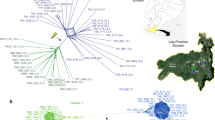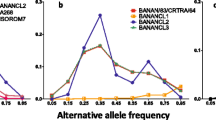Abstract
For the first time, two clones ofTrypanosoma brucei from the same epidemic area in southeastern Uganda were successfully crossed. The cotransmission experiments were as close to natural conditions as possible in that two uncloned isolates from wild-caughtGlosina fuscipes fuscipes were directly cotransmitted in an initial recombination experiment. From the first uncloned progeny population, which revealed a majority of recombinants, two clones with different parental phenotypes [characterized by isocitrate dehydrogenase (ICD) analysis] were isolated. These clones were cotransmitted in a second recombination experiment. Nine clones could be isolated from two different progeny populations of the second experiment, and all showed a recombinant phenotype. These nine clones belonged to three different karyotypes with respect to the large chromosomes (1–3 Mb), which were different from those of either parental parental karyotype or the sum of both parental karyotypes. The results indicate that genetic recombination might well occur between trypanosome populations transmitted within the same epidemic area.
Similar content being viewed by others
References
Enyaru JCK, Stevens JR, Odiit M, Okuna NM, Carasco JF (1993) Isoenzyme comparison ofTrypanozoon isolates from two sleeping sickness areas of south-eastern Uganda. Acta Trop (Basel) 55: 97–115
Gibson WC (1989) Analysis of a genetic cross betweenTrypanosoma brucei rhodesiense andT.b. brucei. Parasitology 99: 391–402
Gibson WC, Whittington H (1993) Genetic exchange inTrypanosoma brucei: selection of hybrid trypanosomes by introduction of genes conferring drug resistance. Mol Biochem Parasitol 60: 19–26
Gibson WC, Marshall TF de C, Godfrey DG (1980) Numerical analysis of enzyme polymorphism: a new approach to the epidemiology and taxonomy of trypanosomes of the subgenusTrypanozoon. Adv Parasitol 18: 175–246
Jenni L, Brun R (1982) A new in vitro test for human serum resistance ofTrypanosoma (T.) brucei. Acta Trop (Basel) 39: 281–284
Jenni L, Marti S, Schweizer J, Betschart B, LePage RWF, Wells JM, Tait A, Paindavoine P, Pays E, Steinert M (1986) Hybrid formation between African trypanosomes during cyclical transmission. Nature 322: 173–175
Schweizer J, Tait A, Jenni L (1988) The timing and frequency of hybrid formation in African trypanosomes during cyclincal transmission. Parasitol Res 75: 98–101
Schweizer J, Pospichal H, Hide G, Buchanan N, Tait A, Jenni L (1994) Analysis of a genetic cross between two East AfricanT. brucei clones. Parasitology (in press)
Tait A (1980) Evidence for diploidy and mating in trypanosomes. Nature 287: 536–538
Tait A (1983) Sexual processes in the Kinetoplastida. Parasitology 86: 29–57
Tait A, Babiker EA, LeRay D (1984) Enzyme variation inTrypanosoma brucei spp. I. Evidence for sub-speciation ofTrypanosoma brucei gambiense. Parasitology 89: 311–326
Tait A, Barry JD, Wink R, Sanderson A, Crowe JS (1985) Enzyme variation inT. brucei spp. II. Evidence forT.b. rhodesiense being a set of variants ofT.b. brucei. Parasitology 90: 89–100
Tait A, Buchanan N, Hide G, Turner M (1993) Genetic recombination and karyotype inheritance inTrypanosoma brucei species. In: Morzaria SP (ed) Genome analysis of protozoan parasites: proceedings of a workshop held at ILRAD, Nairobi, Kenya, 11–13 November 1992. International Laboratory for Research on Animal Diseases, Nairobi, pp 93–107
Tibayrenc M, Ayala FJ (1991) Towards a population genetics of microorganisms: the clonal theory of parasitic protozoa. Parasitol Today 7: 228–232
Tibayrenc M, Kjellberg F, Ayala FJ (1990) A clonal theory of parasitic protozoa: the population structures ofEntamoeba, Giardia, Leishmania, Naegleria, Plasmodium, Trichomonas andTrypanosoma and their medical and taxonomical consequences. Proc Natl Acad Sci USA 87: 2414–2418
Turner CMR, Sternberg J, Buchanan N, Smith E, Hide G, Tait A (1990) Evidence that the mechanism of gene exchange inTrypanosoma brucei involves meiosis and syngamy. Parasitology 101: 377–386
Van der Ploeg LHT, Schwartz DC, Cantor CR, Borst P (1984) Antigenic variation inTrypanosoma brucei analyzed by electrophoretic separation of chromosome-sized DNA molecules. Cell 37: 77–84
Van der Ploeg LHT, Smith CL, Polvere RI, Gottesdiener KM (1989) Improved separation of chromosome-sized DNA fromTrypanosoma brucei stock, 427–60. Nucleic Acids Res 17: 3217–3227
Van Meirvenne N, Janssen PG, Magnus E (1975) Antigenic variation in syringe passaged populations ofTrypanosoma (Trypanozoon) brucei: rationalization of the experimental approach. Ann Soc Belge Med Trop 55: 1–23
Author information
Authors and Affiliations
Rights and permissions
About this article
Cite this article
Degen, R., Pospichal, H., Enyaru, J. et al. Sexual compatibility amongTrypanosoma brucei isolates from an epidemic area in southeastern Uganda. Parasitol Res 81, 253–257 (1995). https://doi.org/10.1007/BF00937118
Received:
Accepted:
Issue Date:
DOI: https://doi.org/10.1007/BF00937118




